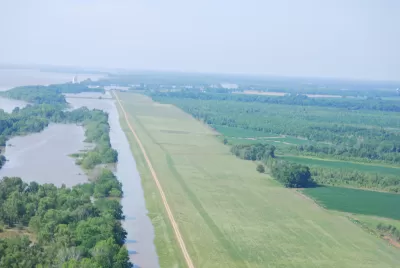A $50 billion plan to replenish lost coastal land could have significant impacts on local marine life and fishing industries.

The U.S. Army Corps of Engineers has released the environmental impact statement that allows a key component of a massive coastal restoration project planned for the Louisiana coast to move forward. Writing in the New York Times, John Schwartz reports that the Corps called the proposed project largely beneficial but expressed concern for the effects it could have on marine life.
The Mid-Barataria Sediment Diversion project is designed to replenish the sediment that has eroded away from Louisiana's coast, sediment that was naturally replenished before man-made levees contained the flow of the river. "If the corps issues final permits, which could happen as early as next year, a $1.4 billion structure will be dug into the western bank of the river below New Orleans. It will include gates that allow operators to control the flow of water and sediment from the mighty river into Barataria Bay, nearly an Olympic swimming pool’s worth of water every second."
To counter negative impacts, the project sets aside "millions of dollars to monitor dolphin populations and protect them, as well as helping to pay to relocate oyster beds to areas that will have the right level of salinity" and fund boat upgrades to help fishermen reach waters farther ashore. Acknowledging the dangers as well as the necessity of the project, Richie Blink, a council member of the Plaquemines Parish government, emphasized the importance of a safety net for "the people who are impacted most by the structure and the project." Opponents argue there are less destructive ways to stave off the effects of erosion, but those methods are more expensive and require more maintenance. Without the project, said Bren Haase, executive director of the state coastal authority, "the alternative is unthinkable. It’s a coastal Louisiana that doesn’t exist."
FULL STORY: Big Step Forward for $50 Billion Plan to Save Louisiana Coast

Planetizen Federal Action Tracker
A weekly monitor of how Trump’s orders and actions are impacting planners and planning in America.

Congressman Proposes Bill to Rename DC Metro “Trump Train”
The Make Autorail Great Again Act would withhold federal funding to the system until the Washington Metropolitan Area Transit Authority (WMATA), rebrands as the Washington Metropolitan Authority for Greater Access (WMAGA).

DARTSpace Platform Streamlines Dallas TOD Application Process
The Dallas transit agency hopes a shorter permitting timeline will boost transit-oriented development around rail stations.

Renters Now Outnumber Homeowners in Over 200 US Suburbs
High housing costs in city centers and the new-found flexibility offered by remote work are pushing more renters to suburban areas.

The Tiny, Adorable $7,000 Car Turning Japan Onto EVs
The single seat Mibot charges from a regular plug as quickly as an iPad, and is about half the price of an average EV.

Supreme Court Ruling in Pipeline Case Guts Federal Environmental Law
The decision limits the scope of a federal law that mandates extensive environmental impact reviews of energy, infrastructure, and transportation projects.
Urban Design for Planners 1: Software Tools
This six-course series explores essential urban design concepts using open source software and equips planners with the tools they need to participate fully in the urban design process.
Planning for Universal Design
Learn the tools for implementing Universal Design in planning regulations.
Municipality of Princeton
Roanoke Valley-Alleghany Regional Commission
City of Mt Shasta
City of Camden Redevelopment Agency
City of Astoria
Transportation Research & Education Center (TREC) at Portland State University
US High Speed Rail Association
City of Camden Redevelopment Agency
Municipality of Princeton (NJ)



























